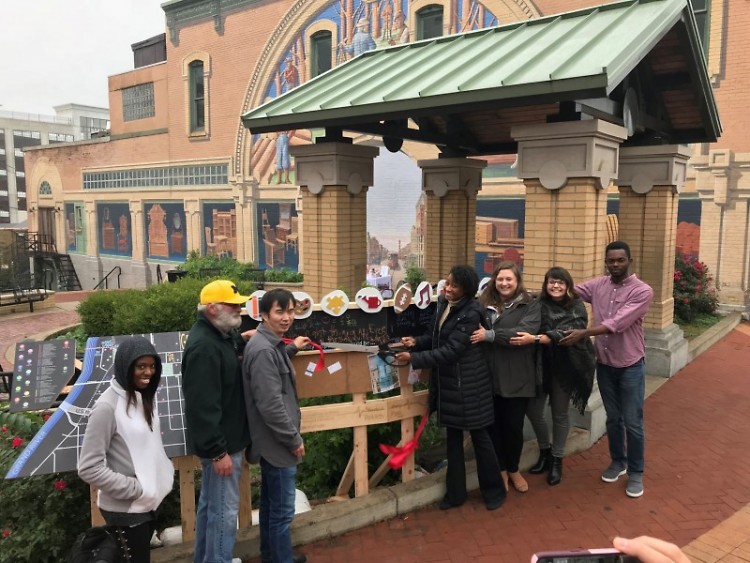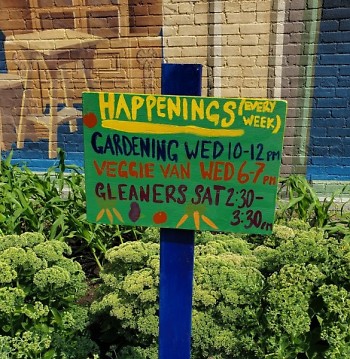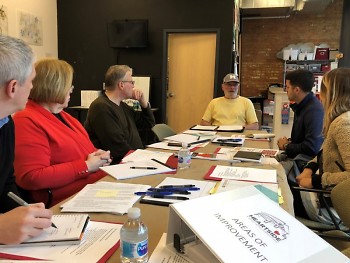The consensus work that Maloney and other local stakeholders have contributed to the Heartside Quality of Life Study is now coming to fruition.
This summer, Pekich Park, which has been a historically problematic area for neighbors, saw investment and activation in the form of weekly community gardening activities, fresh food access initiatives, and art engagement. The activation is in response to community data gathered by the Heartside Quality of Life study, which allowed Heartside residents involved in the Areas of Improvement workgroup to clearly identify the need for interventions at Pekich Park. The season of positive action culminates next week in an evening of celebration: the Pekich Park Garden Party will be a chance for neighbors and newcomers to see the changes to the park.
The park has had a complicated history. As the result of a street-design initiative to improve walkability and re-align Cherry Street, the park was created in 2010 and features a beautiful mural installation and several enjoyable amenities for residents. However, the use of the park quickly shifted. “Often times, if you leave a space vacant, unoccupied or otherwise inactive, then people from outside the neighborhood can come into the neighborhood and turn it into whatever they want it to be,” shares Latesha Lipscomb, Heartside Community Engagement Project Manager for the City of Grand Rapids. Heartside residents are often frustrated by the predatory behavior of visitors who come into the neighborhood and use spaces like Pekich Park to deal drugs, resulting in an increase in loitering, assaults, and robberies.
As Grand Rapids engaged the community with its Heartside Quality of Life Study, launched in Fall of 2017, it became apparent that Pekich Park wasn’t being utilized in its intended manner. Lipscomb explains that the negative reputation the park had gained made it clear that the community needed to, “...(a) reclaim the space and [also] needed to (b) figure out how to positively activate the space for its intended use, which would be a place that all neighbors could enjoy and feel welcome at.”
As a starting point for the Quality of Life Study, neighborhood listening sessions within Heartside took place to gain perspective on what residents would like to see change in the neighborhood. In conjunction, an Areas of Improvement workgroup emerged with one of its main focuses being the activation of Pekich Park. The committee consisted of a diverse group of individuals connected to the Heartside neighborhood. The growing consensus became that community members were afraid to patronize the park due to a myriad of disrespectful behaviors that tend to happen in that public space, and after almost a year of meeting and discussing the ways that Pekich Park could transform, the recommendation from the workgroup was clear: activation.
Activation is defined as “the action or process of making something active or operative.” When talking to community members about the activation of Pekich Park, Lipscomb shared that it expands beyond the generic and into the idea of “change you can see.” These positive changes, that could make an immediate impact and build community ownership over the park, started with implementing an informational board. In collaboration with Kendall College’s Master of Architecture program, the board was implemented as a means to highlight community resources available and promote upcoming events happening in the neighborhood.
There became a natural progression of establishing programs in the park to create a consistent presence that could lead to the positive changes the committee and community members were striving to accomplish. Dwelling Place and DGRI came into the mix when the workgroup recommended a weekly community gardening program. In the summer of 2019, Dwelling Place's community gardener has led community members in beautifying the space with herbs, vegetable plants, and flowers provided by DGRI. The result is a transformation of the space, and community garden volunteers have reported that they have less and less work to do every week as neighbors take action all on their own.
Maloney, who had already been involved in the community garden at one of Dwelling Place’s properties, is proud to have been part of the group at the forefront of this action, and believes it has been making a positive impact on the space. He shared that, “…folk see that there are regular people in that space, and the less-than-desirables can’t really claim it as their own anymore.” His hopes are that this community ownership over the park continues to grow and bring more positive change to the neighborhood. Maloney’s passion, like other community members, comes from the desire for the neighborhood to be a place where individuals in the surrounding communities want to visit, and where individuals from within the community want to live. He believes that, “...people [should] be proud of where they live,” and knows that the culture of Pekich Park plays a role in the reputation of the neighborhood.
Lipscomb shares, “I think the gardening program is extra special because it gives neighbors from Heartside an opportunity to be the change they wish to see.” She believes that, “Dwelling Place is curating a positive experience for neighbors to give them something to do, to keep them active in the park, and at the same time, to pose a great benefit for any neighbor who wishes to partake in their gardening program.”
The YMCA Veggie Van and the Heartside Gleaning Initiative (HSGI) are two additional organizations involved in the activation of Pekich Park. These programs were a part of the larger goal of addressing the lack of fresh food access in Heartside and creating an inviting space where all members of the community feel welcome. HSGI has a long standing reputation of providing fresh fruits and vegetables to Heartside. The organization has been making a positive impact in the neighborhood for years. The addition of the Veggie Van has allowed more neighbors to obtain fresh food access. This collaboration, Lipscomb shares, “...only shows growth and expansion, and it really puts a rubber stamp on the power of collaboration.” Roanna Cooper, Gleaning Coordinator at Heartside Gleaning Initiative, champions the work resident committees and other community members are doing to change the culture of the park space,“it feels like it’s very fueled by working with neighborhood residents about what is going to be meaningful to [them] and how do [they] want to use the space.” The presence of these two programs has helped neighbors reclaim the space and change the narrative of the neighborhood.
Additional funding for arts based activities provided by a grant from the MEDC and the Michigan Council for Arts and Cultural Affairs. Through Community Arts Series activities and events, Dwelling Place encourages communities to thrive by providing access to the arts.
With a mission to improve the lives of people by creating quality affordable housing, providing essential support services and serving as a catalyst for neighborhood revitalization, Dwelling Place serves families and people in 4 counties across West Michigan. Dwelling Place is powered by volunteers and numerous staff persons, guest writers create our Rapidian content. Thanks to Haley Stichman for her contribution of this article.
The Rapidian, a program of the 501(c)3 nonprofit Community Media Center, relies on the community’s support to help cover the cost of training reporters and publishing content.
We need your help.
If each of our readers and content creators who values this community platform help support its creation and maintenance, The Rapidian can continue to educate and facilitate a conversation around issues for years to come.
Please support The Rapidian and make a contribution today.


